Column: What, If Anything, Is a Bicyclist?
Temperatures hit the high 70s at Sunday’s Artisan Market near Kerrytown, where volunteers for Common Cycle were helping people learn about bicycle repair.
And as the weather gets warmer, the primary election season will also start to heat up – just as surely as journalists will appeal to hackneyed clichés to describe it. For local office candidates, as well as commentators on local races, part of the sport is to categorize the community into convenient groupings – like parents, homeowners, renters, students, landlords, environmentalists, developers, new urbanists, preservationists, park-lovers, young professionals, old hippies, the handicapped, business people, transit riders, etc.
I’m not certain that bicyclists would make the list as a voter group. But they’ll serve to make the point I want to make.
Yes, that non-exhaustive list of groupings is a sometimes useful and convenient set of labels. But just as the word “zebra” is a convenient label for those horse-shaped animals with a black and white pattern of stripes, that doesn’t mean that all of those “zebras” are necessarily biologically related.
The title of this column, in fact, is a play on the title of a fairly famous essay by Stephen Jay Gould: “What, If Anything, Is a Zebra?” That essay was written back in the early ’80s and I’m not sure if the evolutionary biologists ever settled the question. I don’t really care – zebras don’t live around these parts, and even if they did, they’re notorious non-voters.
But bicyclists do live around here. And they’ll serve as well as any grouping to illustrate the fact that among any “community” we include in a list of labels, there’ll be smaller sub-communities that have more specialized interests. So we’d do well to avoid thinking of these convenient labels as reflective of any one coherent community.
This column takes a look at three groups of people that could fairly be labeled “bicyclists,” with the idea that they’re separate groups, with maybe some overlap in people, but which are fundamentally different: Washtenaw Bicycling and Walking Coalition, Bicycles Are Traffic, and Common Cycle. I look at each group through the lens of one of their events I’ve attended over the last week and a half.
Washtenaw Bicycling and Walking Coalition: RAT
Friday two weeks ago was Frank Schwende’s final Ride Around Town (RAT), an advocacy ride sponsored by the Washtenaw Bicycling and Walking Coalition (WBWC). Schwende has led the ride on a couple of loops through downtown Ann Arbor – rain or shine, snow or dry – almost every second Friday of the month since Friday, Oct. 12, 2007. The ride starts from Liberty Plaza at Liberty & Division.

Frank Schwende, left, helps Aren Stobby affix a toy stuffed rat to his helmet. Stuffed rats are the unofficial mascot for the Ride Around Town (RAT).
That inaugural RAT was documented on ArborUpdate (AU), a recently-defunct community discussion and information source. Its online archives continue to serve as useful public history from roughly 2005-10. Steve Bean, now a candidate for mayor, participated in that first ride and reported back to AU that there had been eight participants: “We got several supportive comments from pedestrians, a few honks, and lots of curious looks.”
The point of the ride, as Schwende explained to the gathering of bicyclists at Liberty Plaza over a week ago Friday, was to “take to the streets, not take over the streets.” It would be a demonstration, he said, of how bicycles could be operated like vehicles. The group would be signaling turns and stopping at stop signs, he told the roughly 15 riders assembled on the plaza.
As we headed west on Liberty towards the State Street area, an Ann Arbor fire department ladder truck sped past us with siren and lights going. We caught up to it as it parked near the intersection of North University and State, but it wasn’t clear what the nature of the emergency call was.
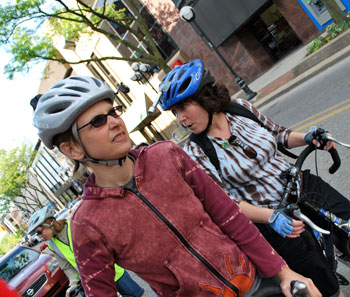
Kris Talley, left, and Karen Moorhead, right, as the RAT pauses on Main Street at Washington for a traffic light.
Cycling along with the group, I chatted with Kris Talley, who’s a current board member and past chair of the WBWC. The group recently achieved official nonprofit status, effective April 1, 2010, which she said was an important step in positioning the group to be a strong advocate for cycling and walking. Donations to the coalition are now tax exempt.
The RAT is one of several different projects the WBWC works on. Others include participation in local and regional non-motorized planning efforts with the city of Ann Arbor and Washtenaw County, and sponsorship of valet bicycle parking at the Ann Arbor art fairs.
The post-ride meal, which has evolved into a tradition for the RAT, was at Tios. The first “rat hole” – as Schwende is fond of calling the rotating location for the post-ride meal – was also at Tios. At that time, though, Tios was located on Huron Street. [The building was purchased by the city of Ann Arbor and demolished. In their new location, and equipped with a liquor license, business at Tios appears to be good.]
Why was last Friday’s ride Schwende’s last RAT? He’s moving to Colorado – to Fort Collins to be exact. The 60-year-old Schwende will work his last day at the U.S. Environmental Protection Agency’s Ann Arbor site on May 27, and will head to Colorado on June 15, where the “roads are wide and the beer is good.”
But in Ann Arbor, the RAT will continue. Among those who gathered at Tios after the ride was Pete Hines, recently elected chair of the WBWC board, who’ll be ensuring that the rides have a leader. Though Hines did not ride on Friday – he was nursing some “road rash” from a spill he took on his bike – he’s ridden most of the RATs over the last two and a half years.
Bicycles Are Traffic
Among the 15 or so riders on last Friday’s RAT were several folks under 30 years old, including Tom Wright and Aren Stobby – they’re housemates and work together at the Black Pearl restaurant on Main Street.
Stobby was riding a 1976 vintage 10-speed that belonged to his dad, and was still adorned with its Michigan State University campus bike registration from that era. Wright was astride a 1964 Hiawatha Gambler that he’d acquired from his friend Bob a few days earlier.
Dave Fanslow, who rode the RAT on Friday and is not, ahem, under 30, offered to buy the first round at Tios for anyone who was under 30. The invitation didn’t result in any of the under-30 crowd sticking around for the post-RAT meal.
But Wright told the group that he was planning a ride a week later – on Saturday, leaving from the University of Michigan Diag, organized under the name Bikes are Traffic. That’s just a name, as far as I can tell – it’s not an entity on its way to formal organization as a nonprofit.
Figuring I’d give a nod to bridging the generational gap – I’m also not under 30 – I headed over the the Diag at the appointed 1 p.m. gathering time for the 1:30 p.m. ride-out. Wright and I were the only two who showed up. Wright attributed the poor turnout to a schedule conflict with a DIY craft fair the same day. Undeterred, the pair of us headed out of the Diag north towards the intersection of State and Liberty.
We quickly picked up a friend of Wright’s, Liam Carroll, who was riding a green-rimmed fixed-gear bike. A few years earlier, Wright and Carroll had both sung in the Ann Arbor boy’s choir. Carroll hadn’t planned to ride, but responded to Wright’s invitation to ride along: “Where?” “Just around.” “Oh, I’ve been there before, but wouldn’t mind seeing it again.”
And so we wound through the downtown, with the helmetless Wright signaling his turns, hewing to the traffic laws – even those requiring vehicles to yield to pedestrians in crosswalks.
When Wright braked to a halt at a mid-block crossing between William and South University on State Street, it earned him a thank-you from the pedestrians who were standing in the walk waiting for traffic to clear.
Wright said there’s often more of his cohorts from the downtown food-retail scene – he works at Cafe Ambrosia as well as at The Black Pearl – who take to the streets late on Monday nights for a spin through the downtown.
Whereas WBWC is more of a formal advocacy group adorned with the trappings of nonprofit status, Tom Wright and Bicycles are Traffic are more of a loose federation whose enthusiasm for bicycles is realized in somewhat more spontaneous form.
Common Cycle
Common Cycle is a relatively new group, self-described on its website as in its “infancy” and looking to empower “Ann Arbor to ride bicycles by providing access to education, workspace, and resources.” They’re looking for help from like-minded people. One missing ingredient so far is a permanent space to work.
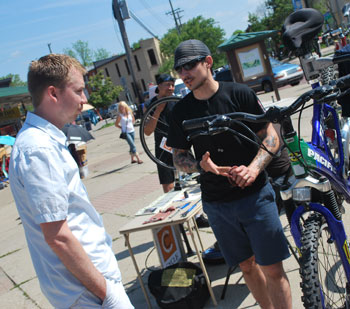
At Common Cycle's mobile repair stand, Jonathan Roe, left, gets some mechanical advice from Jimmy Raggett.
So their mission is currently being realized in the form of a mobile repair stand they’ve operated for the last few weeks at the Sunday Artisan Market in Kerrytown.
This Sunday found Jimmy Raggett, who heads up the service department for Two-Wheel Tango‘s Jackson Road store, running the repair stand. The previous week, Jonathon Roe had noticed Common Cycle at the market, so on Sunday he brought his bicycle over for a diagnosis.
Raggett’s verdict: The front disk brake needed a new caliper, but the rear V-brakes could be restored to working order with some cabling and pads. Raggett offered to take Roe’s email address and coordinate tracking down parts for next Sunday. And Roe took him up on the offer.
Hanging out with the Common Cyclers was Jimmy White Bull, 42, who grew up in Ann Arbor. “Are you with Common Cycle?” “No, but I’m commonly around.” White Bull recalled how the brick paving of the streets used to be more prevalent than just around Kerrytown – he enjoyed the feeling of riding a bike along the brick, he said. White Bull said he’d participated in several of the alley cat bike races Raggett has organized over the last few years.
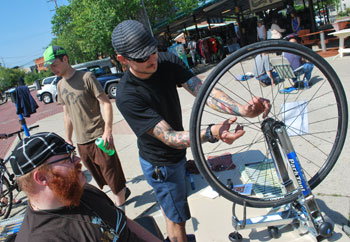
Thomas Kula, seated, gets his spoke tension evaluated by Jimmy Raggett. In the background (with a green water bottle) is Evan Williams.
Also fitting that description at the Common Cycle mobile repair stand on Sunday was Thomas Kula, who was learning from Raggett how to true wheels. Kula, I knew, helped organize the most recent Cranksgiving event, an alley cat bicycle race which donates its proceeds to Food Gatherers. The first Cranksgiving event in the Ann Arbor area was spearheaded by Andy Hromadka, a board member of WBWC.
So given the apparent connections, why is Common Cycle pedaling down a path to become its own nonprofit organization? Why not just fit themselves under the umbrella of WBWC?
Part of the explanation that Common Cycler Bill Merrill sent to me by email is that members of this like-minded group – committed to a common workspace and the programs that could come from that – didn’t first meet in the context of the WBWC.
And Pieter Kleymeer, also via email, stressed that Common Cycle is talking to groups like WBWC, as well as the Kiwanis Club, and getDowntown, but that Common Cycle has a specific strategy for their advocacy. While the WBWC can put pressure on local governments to build infrastructure, he wrote, Common Cycle wants to “put more bikes on the road than the current infrastructure can handle.”
Kleymeer might have something in mind like this bicycle rush hour video shot in Utrecht in the Netherlands. [By way of comparison, Ann Arbor has a population of a bit over 100,000, while around 300,000 people live in Utrecht.]
Coda
Of course, the three bicycling communities I covered in this piece aren’t exhaustive of all bicyclists. Some readers are perhaps most familiar with another species of bicyclist – the skin-tight-shorts-and-jersey-wearing, energy-gel-slurping recreational athletes who zip along Huron River Drive. But even they will fall into smaller subsets – there are the triathletes who are thinking about their next swim or their next run, and the pure road cyclists, who just stick to cycling.
There’s also folks who toodle along on a quiet cul-de-sac with their children riding little 16-inch wheel bikes with training wheels. And there are myriad others who can’t be excluded from the classification of “bicyclist” – but it would be a mistake to draw conclusions about what “bicyclists” think based on any one of these subgroups.
And the same is true, I think, of any other broad category label that’s likely to be applied to other groups of people during primary election season.




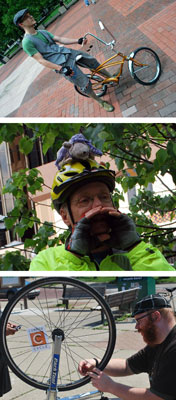

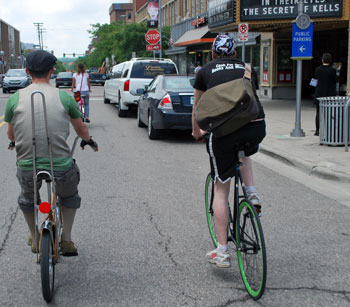
Just wanted to give a shout out to Frank to thank him for putting together the RATs! His enthusiasm for bicycling was second to none. And for the folks in Colorado, if you ever have an “Office Space” party, you simply MUST invite him :) Safe travels, my friend.
I would not want to be categorized in any of these groups. It would be nice if we could be like many Europeans I’ve observed who are simply people who use bicycles to get around. They would never consider themselves “cyclists.” People get intimidated if they think they need matching uniforms and special equipment. Let’s just ride our bikes to get where we have to go.
Thanks for the nice coverage of the RAT rides Dave. Frank we will definitely miss you!
@ Joan– While I understand your desire to just get on your bike and go, and not have to have a group affiliation, it isn’t always that simple. I’m sure as a biker, you know that.
The Washtenaw Bicycling and Walking Coalition, WBWC, is made up of riders just like yourself who want to bike from point a to b (for pleasure, health, to make the planet a bit healthier, etc), but found that their journey wasn’t so easy. Unlike many European bike-friendly cities, we (Ann Arbor, Michigan, the US) doesn’t yet invest in bike facilities the way our European counterparts do. Just consider riding your bike to the Whole Foods on Washtenaw Avenue from downtown and it becomes obvious how many pieces of our system are broken. And, sadly, many drivers often don’t welcome bikers on the roads as legitimate users of the system, rather they squeeze us off the road or yell at us to get on the sidewalk. And, there are a host of other issues bikers run into on a daily basis.
So everyday people, tired of hoping for a more bike-friendly environment and grumbling about the obstacles, created groups like WBWC to do something productive and work for the changes (better education for cyclists and motorists, predictable enforcement, better facilities, increased funding for infrastructure, etc) that would allow us to jump on our bikes with the care-free worries of a European “cyclist.”
Nice article Dave. Though I am not a joiner of groups (I ride almost every day until the roads/sidewalks become icy) I can see their value. It is nice to see continual installation of bike lanes.
It would be nice if RAT changed their name/acronymn and mascot. The implication of a RAT is not a group I would ever want to associated with: I guess they are trying to be humorous, but it doesn’e resonate with me.
I really will miss being part of the developing and complex bicycle culture in A2. Just a few comments on a fine article. I liked your version, Dave, but the quote about Fort Collins as told to me is “Where the streets are wide and the minds are narrow.” Turns out the beer is also excellent. BTW, folks I’ve already met there are surely not narrow minded.
Harry Wray’s book, Pedal Power, discusses the broad range of folks who come together to promote bicycling. The WBWC organized a group read of that book over a year ago. That book, and my participation in a National Bike Summit in Wash. DC, onvinced me of the need for a stronger advocacy group in A2, because success in this effort will take a serious effort over many years. With the leadership in place and federal non-profit status, the WBWC is positioned to lead the effort to effect real change in the Ann Arbor area.
Whether your a Tweed rider, a Fixter, a Roadie, a Non-cyclists who rides a bike, a Freak biker, a Yellow vested commuter, a Trailer towing biker, or whatever type of rider you are, we all share in the experience of being a vulnerable minority on the roads. We can’t afford to subdivide ourselves into those smaller groups when it comes to advocating for better conditions. Bikers Unite!
…This is a good article. Now if only we could get the bike hipsters to ride in the road ALL the time, not just when people are looking at them.